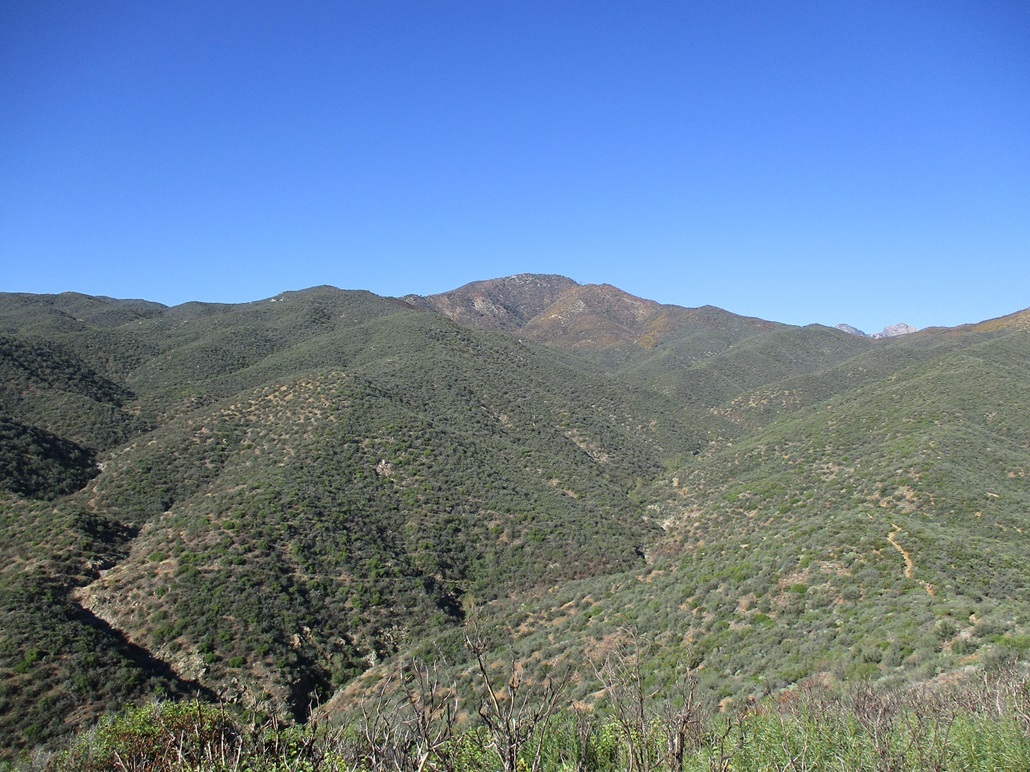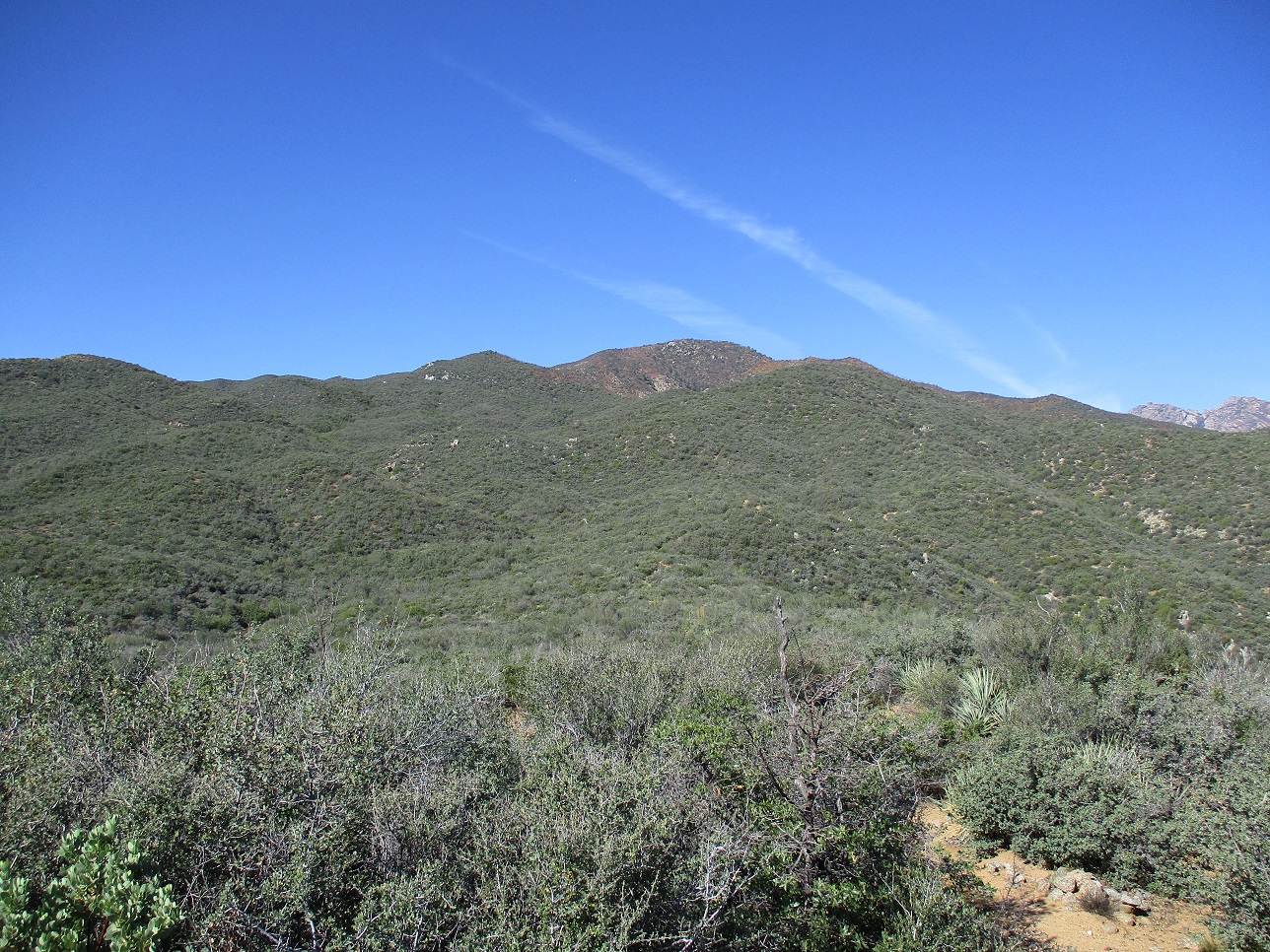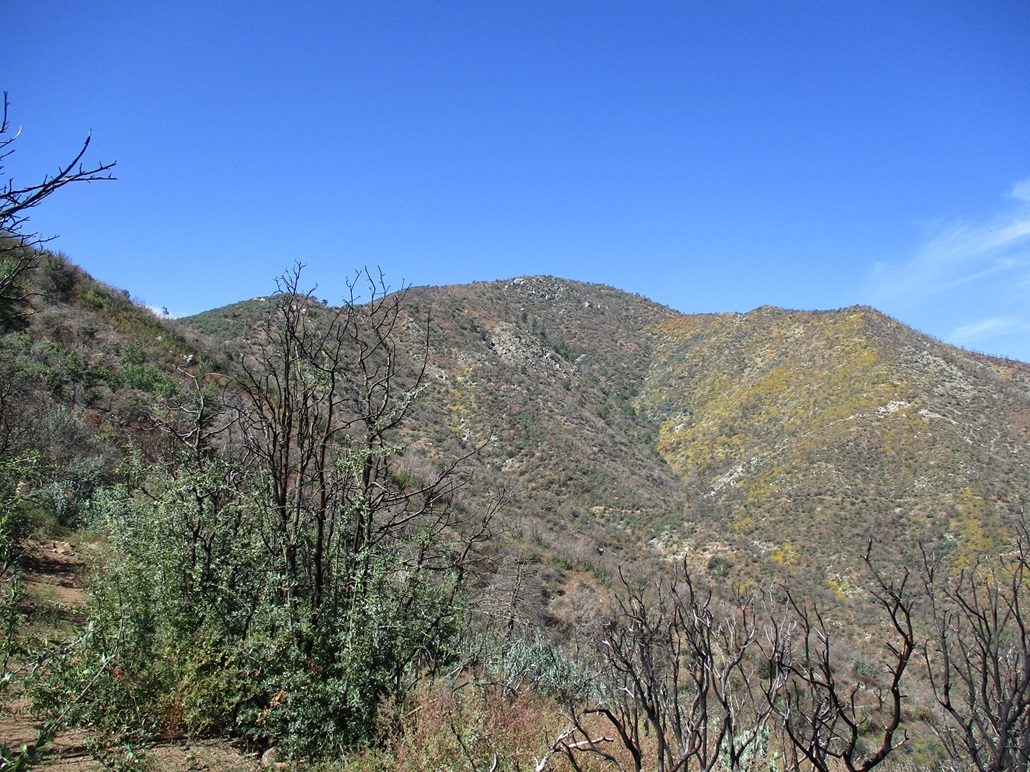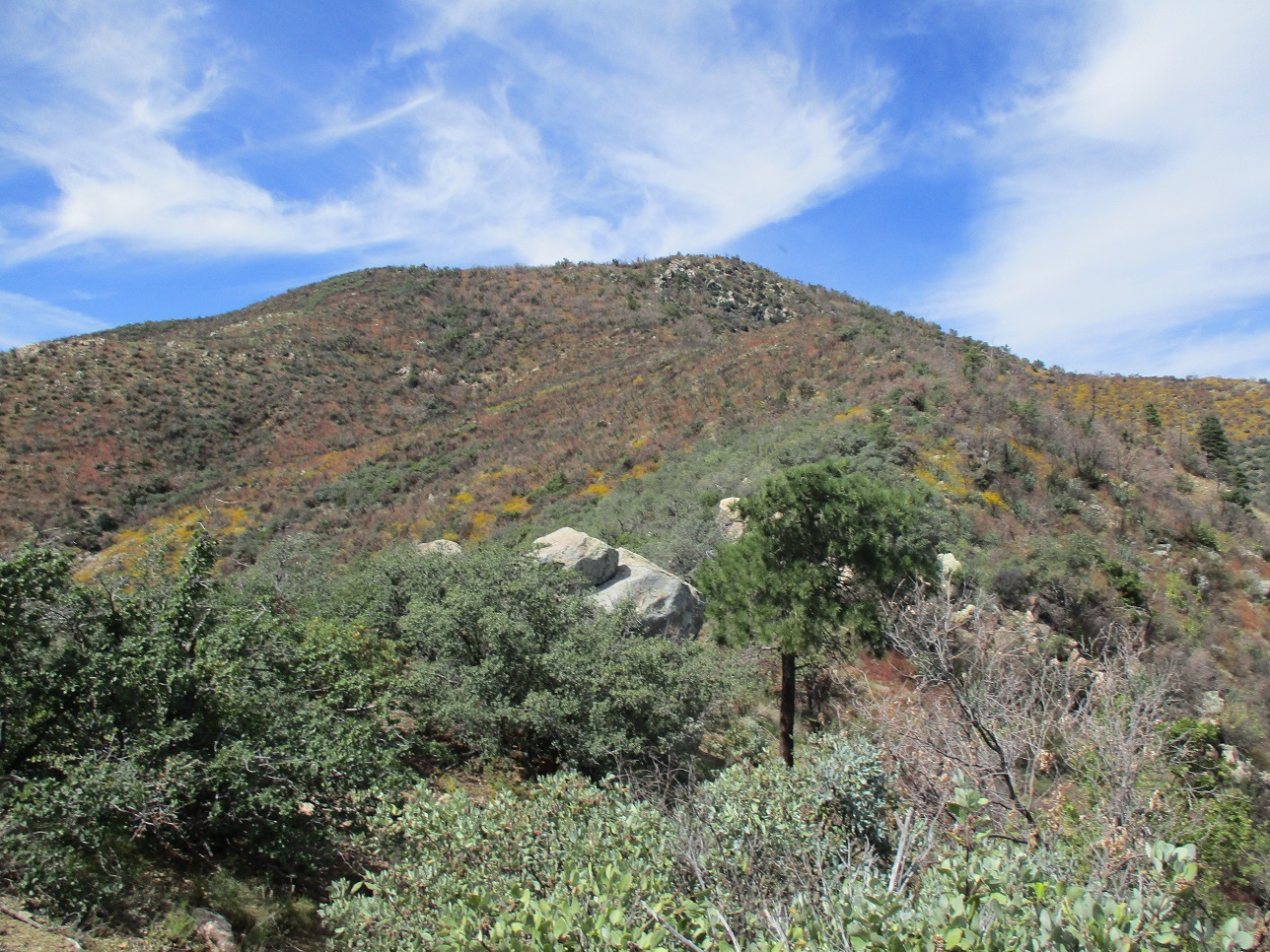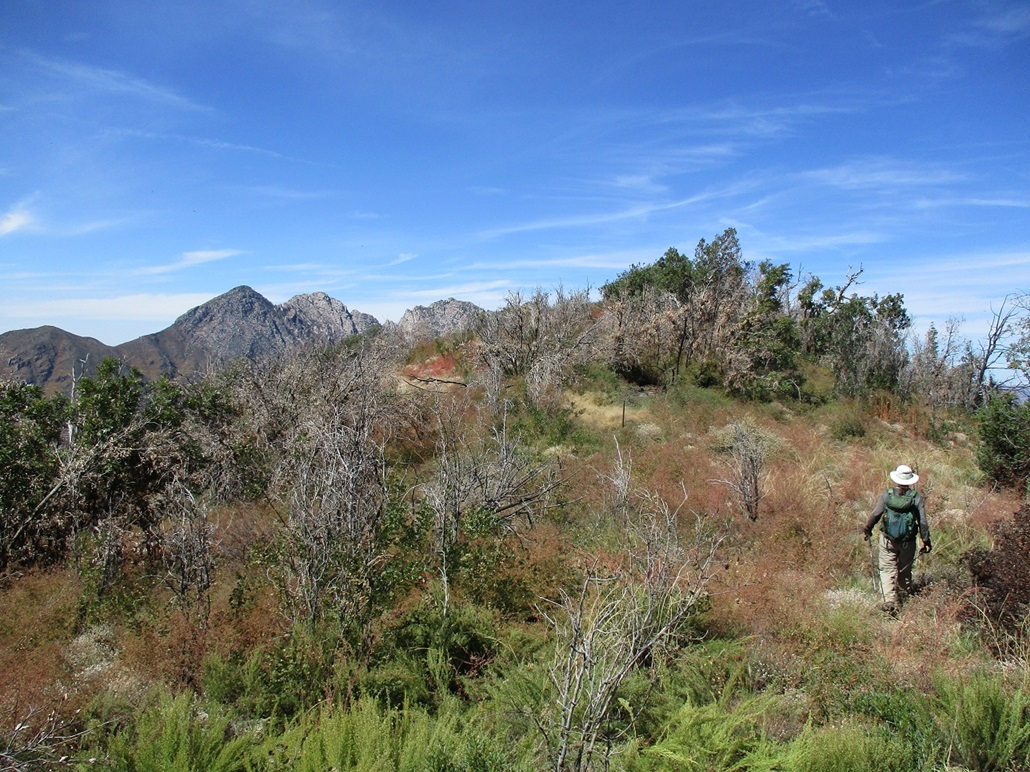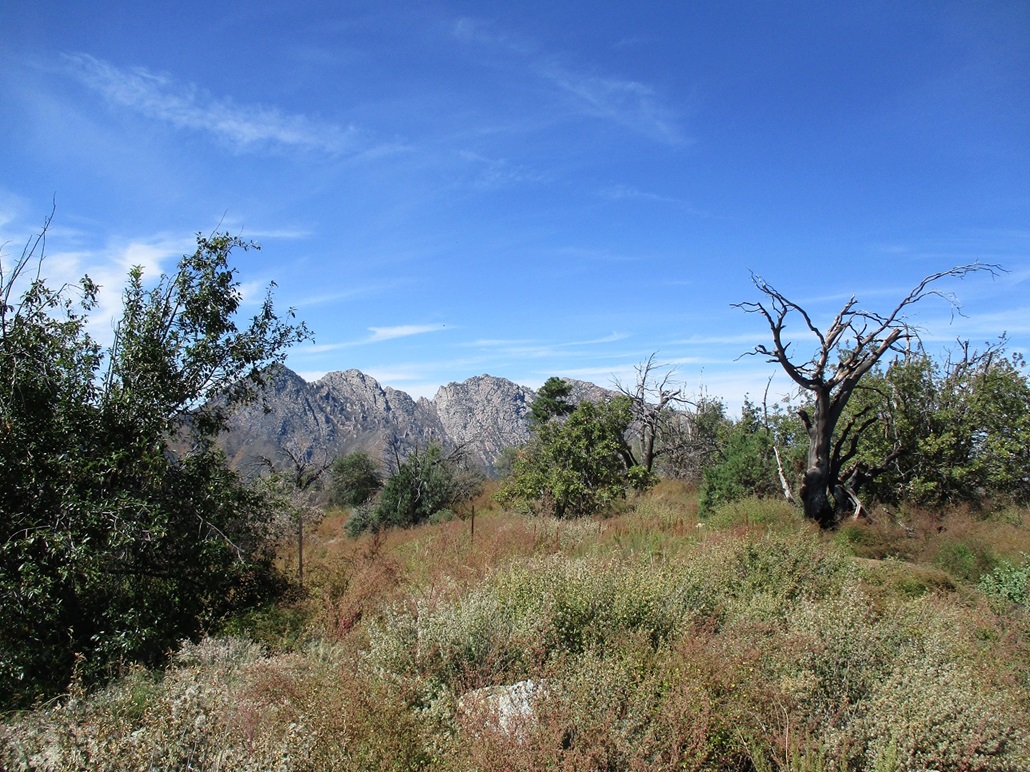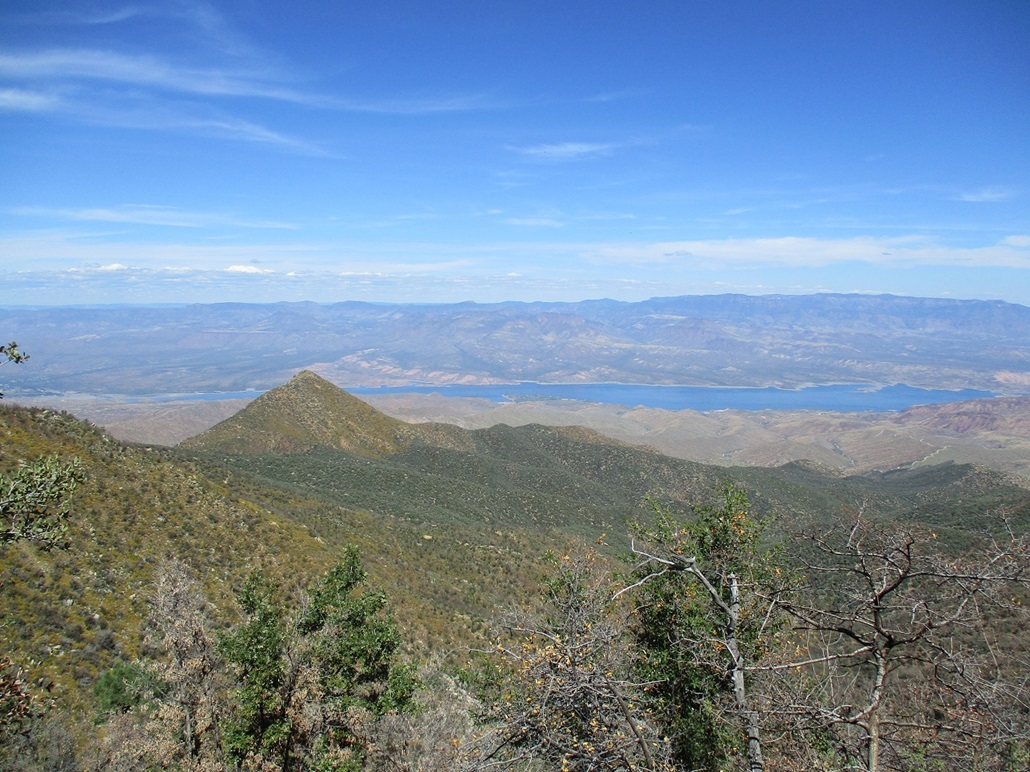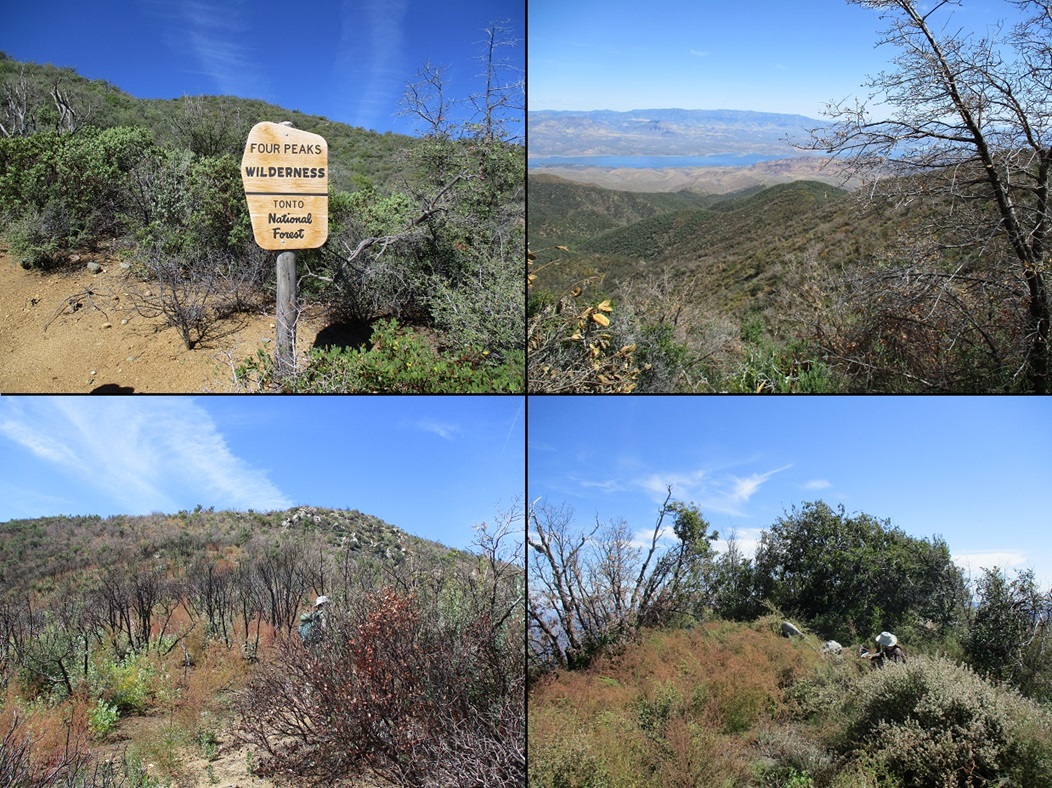
The Mountains of Arizona
• www.surgent.net
|
| Buckhorn Mountain |
• Mazatzal Mountains • Four Peaks Wilderness • Tonto National Forest • Maricopa & Gila Counties |
|
Date: October 2, 2021
• Elevation: 6,612 feet
• Prominence: 1,012 feet
• Distance: 9.3 miles
• Time: 8 hours & 20 minutes
• Gain: 3,640 feet (gross)
• Conditions: Sunny and clear, possibly a tad warm
• Teammate: Matthias Stender
• Prog-rock bands played: D.F.A.; Potemkine
Arizona
•
Main
•
AZ P1K
•
PB
•
LoJ
Buckhorn Mountain is a major summit on the south end of the Mazatzal Mountains. To the north is the Four Peaks massif, and to the south is the Salt River Canyon. Looking east is Lake Roosevelt, and west is Phoenix. From Phoenix, the peak does not stand out much, since the range kind of bends away to the east. It is better viewed from the eastern suburbs like Mesa and Apache Junction, but you have to know what to look for and foreground mountains may hide it anyway. The best view is along state route AZ-88, where it heads northeast near the First Water Trailhead. The long loaf-shaped ridge to the right of the obvious Four Peaks is Buckhorn Mountain. Despite its thousand feet of prominence, it can hide very effectively. However, Matthias and I were aware of it. Being a thousand-footer in terms of prominence, we were compelled to hike it sooner or later.
We had tentatively planned to hike a couple of low peaks up on the Mogollon Plateau, the ones we missed out on when we hiked Chavez Mountain a couple weeks ago when his Toyota got a flat. However, it had rained a couple times since then and we had reasonable concern those roads would get muddy, and truthfully, I was not that enthusiastic about those two peaks. So we traded some ideas. Matthias suggested Buckhorn, and I was immediately interested.
There's little information on the web about hiking to Buckhorn. Old maps show a trail that goes up and over the summit, so it looks easy. However, that trail no longer exists. The newer Arizona Trail was rerouted to run below and east of Buckhorn Mountain, missing the top entirely. There was a massive fire up here in about 1997, and I theorize that fire obliterated the forest and may have prompted the Forest Service to abandon this portion of the trail when the Arizona Trail was being conceived about that time.
The only decent information we had was from HikeArizona, by a group from 2015, including Scott Kelley, one of my old hiking pals before he moved away. A couple in that group explored the "old trail" ridge. They mentioned the brush and bailing early. The Mazatzals are notorious for heavy, gruesome brush. But they did it, so that suggested it was possible. Maybe we'd find old trail openings or remnants to follow.
Our plan was to hike the Arizona Trail a few miles to the base of the eastern ridge from the summit, where this older trail would have existed, then bust up that ridge and hope for the best. We figured the Arizona Trail portion would go fast since it was a good trail, and that the east ridge portion would go, since from afar it was not covered as thickly in woody brush as the rest of the slopes. Were it not for the Arizona Trail, busting directly through the manzanita, cat-claw, agave, holly and mountain oak would be near impossible.
We met at the Target on Shea Boulevard in Fountain Hills at 6 a.m., drove northbound on the Beeline (AZ-87) to its junction with AZ-188, then southeast about 30 miles to Tonto Forest Road 429, the access road to the Mills Ridge Trailhead, one of the access points to the Arizona Trail. Matthias was driving since his vehicle was better suited for the road to the trailhead. From the highway, FR-429 runs five miles and gains about 1,500 feet. We found the road to be better than expected (more on this at the end). We rolled into the tiny parking area about 7:50 a.m., the day sunny and cool. We were the only people here. After a few minutes of getting suited up and properly packed, we started walking at 8 a.m. sharp.
The Arizona Trail (Trail 130 here) spans the entire state, and in this portion, starts down at the highway and heads north along the east slopes of the range toward Black Bear Saddle, which is the main saddle north of Buckhorn Mountain and south of the Four Peaks. The trail is one of Arizona's biggest hiking attractions and receives probably a little more attention than most other trails in terms of upkeep. From the trailhead, the trail gains elevation immediately and with little variation. It is a consistently steep uphill grind. Down this low (about 3,700 feet elevation), the forest and brush was light, mainly grasses and cactus. The trail itself was rocky but usually in good shape. In spots, it was overgrown slightly by grass.
We had an interesting encounter: we found a backpack just laying on the trail, obviously new and fully stocked. So we called out and heard a voice. My first assumption was that its owner was not expecting us and wanted a little privacy to attend to important business, so we went on. A few minutes later, the guy came upon us. He had lost something along the way and was looking for the lost object. He was one of those people with a third lung and soon he was on his way, moving quickly. For the next hour or so, we'd occasionally see him up ahead on the route. He was a thru-hiker.
In about 45 minutes, we'd covered about a mile with about 900 feet of gain, topping out just south of a small hill, elevation about 4,580 feet. Here, we had our first really good view of Buckhorn Mountain up on the range crest. A green mat of trees and brush covered every square inch of the mountain except for the very top, which "appeared" to be more open. How naive we were.
The trail then drops nearly 300 feet over the next half mile, bottoming out in Buckhorn Creek. This was not exactly welcome, since that mean we'd have to regain that 300 feet on the way in, and again on the way out. Clearly, the downhill hike went quickly. We walked up the other side of Buckhorn Creek then took a break in a shaded area. The next segment was another steep haul up a bunch of switchbacks, to place us near Point 4946, where the trail flattens out slightly for a short ways. We took another quicky break here, then dropped 80 feet into Hackberry Creek.
In Hackberry Creek, the trees are taller and more forest-like, much prettier than the waist-high manzanita we'd been hiking through up until now. There are a few flat cleared areas that could be used for camping. Up ahead, according to the map, is a trough near Granite Spring. Within this small canyon, we heard some slow rustling in the trees. We suspected a bear, since they're common in this range, and since we'd seen about a dozen fresh piles of bear scat along the trails up until now. We clapped, banged our sticks and hollered to scare it off. I got my bear spray handy just in case.
We hiked up past the trough (we never actually saw it), gaining more elevation to place us on a saddle at elevation 5,500 feet, just northeast of Point 5876. The topographical maps still show this old trail alignment going uphill past Point 5876 and onto the summit. We took a longer break here to plan our attack. Buckhorn Mountain stood above us, about 1,100 feet higher and a mile away. The Arizona Trail itself is visible as a line cutting across and below the summit. We even saw that guy from earlier on it; he was nearly a mile ahead of us by now. He clearly was not going to the summit. Not only was he a quick hiker, he was smart, too.
We looked for some clue where the old trail would have veered uphill. Nothing stood out, so we found an open area and started uphill. It was brushy but not too bad. We could keep to open lanes and soon had gained most of the elevation to near Point 5876. This part had gone reasonably well, lulling us into complacency.
We sidehilled a little, as the ridge loses about 50 feet. The trees and brush got extremely thick here. We generally stayed slightly right (north) of the ridge, bashing and crashing through the tangle. The small trees' limbs would inter-weave with one another, forming a mesh of branches. We push through, trying to manage the hidden rocks, cactus, catclaw and other hazards. There was this long grass succulent with slightly reddish stalks that was very pliable, but it would collect around our ankles, tripping us. Oh yes, we were also mindful of snakes.
We were able to get partway up the next slope into an open area, where we took a break after all that energy just to make about 500 feet of progress. Up ahead was an open lane, then a low band of rocks. Maybe the worst was over.
We got above the rocks fine, but the brush ... it never let up, and seemed to get worse. Nothing looked open. We had to backtrack too many times to count to try different ways through. We got through it, but it was brutal. At times, we simply pushed through it, using sheer force to power through the crud. This was exhausting and not fun at all. We took another break, still 0.4 mile from the top with 500 feet to gain.
The next uphill segment ganed most of that 500 feet. There were some obvious rock outcrops and jumbly cliffs to our right as we looked up, and the slope to the left appearing to have slightly less of the heavy woody brush, but more of that ankle-grabbing grass (try as I might, I cannot determine its actual name by looking at images on the web). There were abundant wildflowers too. We grunted up this slope, finally on the upper-most ridge, the summit just another few minutes' hiking away.
We arrived onto the flattish summit, the top-most rockpile hidden within a tree, but the small summit ridge more open, with outstanding views of the Four Peaks. This is easily the best viewpoint of the Four Peaks. Views in all directions, when not blocked by trees, were also impressive. The Sierra Ancha rose to the east, behind Lake Roosevelt. The Superstition Mountains rose to the southwest. We spent about 15 minutes up here. I did not check the time, but later, looking at the metadata from my photos, it was close to 1 p.m. when we arrived, meaning about a five-hour ascent. The net elevation gain was 2,900 feet, not counting the drops and regains. We had covered about 3.7 miles on the Arizona Trail, and a mile off trail.
I had packed three large Gatorades and two pints of water, about 7 pints in all, but had ran through it faster than expected. At the summit, I had one 1.5-pint bottle of Gatorade, and one 1-pint bottle of water remaining. This would have to last me for the 4.7-mile hike down. It was pleasant, but warm, about 70 degrees up this high. I knew I'd be cutting it close with the water on the hike out. Matthias was in the same predicament as I was. We agreed if one of us ran low, we'd fight to the death for the last bottle of water.
The hike down was, how to put it, one of the suckiest hikes of my life. We had a thousand feet of nasty brush to descend through. We were able to follow our ascent route downhill since we had bashed down so many of the grasses. At other times, in the heavier woody stuff, we just barged through it, no real attempt to keep to open lanes. We had gravity on our side. We got down about 800 feet to the ridge just west of Point 5876, then decided to bail down a drainage directly to the Arizona Trail, about 400 feet below.
We angled down slope, aiming for the drainage, which was brushy but slightly more open due to its rocks. But the brush was unbelievable here too, not any better than if we'd stayed high and retraced our route entirely. But were we well down the drainage and committed to it. I was mainly in front, doing the branch-breaking and cussing to get through it. It was utterly exhausting and thoroughly unenjoyable. But we were bound to meet the trail, and we did. It was a welcome sight and a relief to be off the wretched brushy slopes once and for all. We were about a third of a mile west of that saddle where we had started up the brushy slopes. We hiked back to this saddle and took another break. I had run through most of my Gatorade by now. I was totally bushed, but still had 3.7 miles to walk. I had just my one 1-pint bottle of water. It was warm and I was parched.
The downhill hike went well, insofar as it was downhill and now with more shadows. It was warmer now. In my tiredness, I stumbled and slipped more on the loose portions of the trail. I was nursing that one bottle as best I could. I wanted to leave "most" of it until I had surmounted that 300-foot regain up from Buckhorn Creek. We got down to the creek, then started up the other side. At this time I told Matthias I would have to hike this out at my own pace, so he went on ahead.
I just went real slow. I took baby steps, kept my mouth shut, trying to breathe through my nose only. I took a number of breaks in the shade. I blanked out my mind and just concentrated on the slow walk. I slowly regained the 300 feet, then walked downhill a ways where I stopped to take a break and basically gulp down the remaining water. I still had a mile to go.
The last mile went slow but I made it. Matthias was already back, and he had a jug of water sitting in his car available. I gulped down about 3 pints in one long swig. It was that tastiest warm water I've ever had. It barely quenched my thirst but at least put me back into safer territory. Seriously, if I had not packed 7 liters, or if the trail was a mile longer, I would have been in real trouble. This was a little too close for comfort, and reminds me to never underpack water. This time I did. I was back at the car about 4:20 p.m.. I changed into less filthy clothing and we soon started the drive downhill and back to Fountain Hills. It was close to 6 p.m. when we arrived. We topped the gas, I got my car repacked, we shook hands and congratulated one another on this very hard-earned peak.
Since Matthias drove, he was the boss of the music. He played more of the Italian group D.F.A., then a French outfit called Potemkine, from the mid 1970s. They were good, much more jazzy than groups from that era. Think of Patrick Moraz on Yes's Relayer album, and you get the idea. We also discussed the recent passing of Dr. Lonnie Smith, one of my favorite jazz organists ever. He had just died a couple days prior.
The post-mortem:
We were both very happy to finally tag Buckhorn Mountain's summit, but both agreed the bushwhacking was awful. Unless you are dead-set on climbing as many P1K peaks as you can, this particular mountaintop can be skipped. If you choose to go, be ready for some intense brush. Bringing along snips may not be a bad idea. Wear long everything. And don't under-estimate the effort, so bring extra water just to be safe. I am happy to have this one checked off, but never ever want to do battle with that brush again. There is a good reason so few people have climbed it, and that many who have did so twenty-plus years ago. It may not see another visitor for another five years, maybe longer if people actually read this here.
The Arizona Trail itself was not as in good of condition as we were expecting. It was overgrown in areas, and eroded in other areas. It has been a wet summer, and likely has seen few people during the summer anyway, so this degradation is not surprising. It will need a little upkeep by the stewards soon. However, this slowed us a little.
The road in was not too bad. A couple years ago, I scouted it in my Subaru Forester. A guy coming down said "I'd need a Jeep" for the road, so I went in no farther. Matthias' Toyota SUV handled it well. The problem is not clearance, as the road is mostly smooth for the five miles to the trailhead. It's a few spots of ruts and erosion, and a couple short steep segments, that would be trouble for normal cars. I think if I went slowly and was real motivated, I could have inched my Forester past these handful of challenging segments, but it would be borderline. My opinion is that you probably should err on the side of a beefier vehicle. Conditions can change, so what may be true now may not six months from now.
The food at the nearby Señor Taco, near Shea Boulevard and the Circle K, was very good. I got three chicken soft tacos and that helped me recover once back home.
|
|
